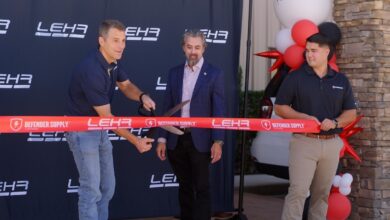AAA: New-Vehicle Technologies Double Repair Bills for Minor Collisions
Vehicles equipped with advanced driver assistance systems (ADAS) can cost twice as much to repair following a collision due to expensive sensors and their calibration requirements, according to new research from AAA.
Even minor incidents that cause damage to the technology found behind windshields, bumpers and door mirrors can add up to $3,000 in extra repair costs.
“Advanced safety systems are much more common today, with many coming as standard equipment, even on base models,” said John Nielsen, AAA’s managing director of Automotive Engineering and Repair. “It’s critical that drivers understand what technology their vehicle has, how it performs and how much it could cost to repair should something happen.”
Previous AAA testing has shown that ADAS offers many safety benefits, however, minor vehicle damage that affects these systems may be inevitable. For the vehicles in AAA’s study, the repair bill for a minor front or rear collision on a car with ADAS can run as high as $5,300, almost two-and-a-half times the repair cost for a vehicle without these systems.
Windshield damage is especially common, with more than 14.5 million replacements annually. Many safety systems rely on cameras positioned behind the windshield that require recalibration when the glass is replaced. In addition, some automakers require the use of factory glass that meets strict standards for optical clarity. Replacing a windshield on a vehicle equipped with a camera behind the glass typically costs approximately $1,500, which can be as much as three times the amount to replace the windshield on a car without the technology.
“It is not unusual for windshields to get chipped or cracked, especially for drivers who commute on a daily basis,” Nielsen added. “This may be an eyesore on a regular car, but when it falls in the line of sight of a camera or the driver, it becomes a safety issue that needs immediate attention by a facility qualified to work on these systems.”
Vehicles with ADAS may also have radar, camera and ultrasonic sensors located in or behind the front and rear bumpers or bodywork, as well as built into the side mirrors. While most drivers may never find themselves in a collision, these parts can easily be damaged when pulling out of a garage, hitting a mailbox or bumping into other objects, according to AAA.
Many variables, such as the vehicle make and model, the type and location of the sensor and where the work is performed, can affect ADAS repair costs. AAA’s research determined the ranges listed below for typical ADAS repair expenses. Note that these numbers are for costs over and above the normal bodywork required following a collision.
- Front radar sensors used with automatic emergency braking and adaptive cruise control systems: $900 to $1,300
- Rear radar sensors used with blind spot monitoring and rear cross traffic alert systems: $850 to $2,050
- Front camera sensors used with automatic emergency braking, adaptive cruise control, lane departure warning and lane keeping systems (does not include the cost of a replacement windshield): $850 to $1,900
- Front, side mirror or rear camera sensors used with around-view systems: $500 to $1,100
- Front or rear ultrasonic sensors used with parking assist systems: $500 to $1,300
For this study, AAA evaluated three top-selling models in popular categories. The vehicle models were selected from AAA’s 2018 Your Driving Costs study and include a small sport utility vehicle, a medium sedan and a full-size pickup truck. To establish repair part types and costs, all replacement parts discussed are original equipment manufacturer (OEM) components charged at their suggested list prices.
To establish mechanical labor costs, a national average customer-pay rate was determined based on data from National Auto Body Research, as well as AAA Approved Auto Repair facilities, and rounded to the nearest whole dollar amount. Labor rates used do not include state or local taxes, shop supplies fees or hazardous materials disposal charges.
To establish repair times, data was obtained from CCC Estimating (Certified Collateral Corp.), Mitchell1 ProDemand, Safelite, Inc. and Nissan, Ford and Toyota dealer repair facilities.



